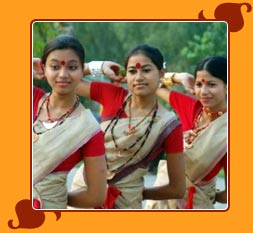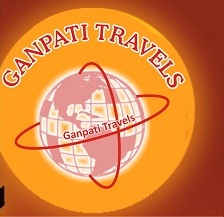The Bihus are the national festivals of
Assam. The most important festivals of Assam are the Bihus, celebrated with
fun and abundance by all Assamese people irrespective of caste, creed,
religion, faith and belief.

In
a year there are three Bihu festivals in Assam - in the months of Bohaag
(Baisakh, the middle of April), Maagh (the middle of January), and Kaati
(Kartik, the middle of October). The Bihus have been celebrated in Assam
since ancient times. Each Bihu coincides with a distinctive phase in the
farming calendar. The most important and colourful of the three Bihu
festival is the Spring festival "Bohag Bihu" or Rangali Bihu
celebrated in the middle of April. This is also the beginning of the
agricultural season.
The "Bohaag Bihu" (also called as "Rangali
Bihu" or the Festival of Merriment) marks the beginning of the New Year
- the seeding time. The "Kaati Bihu" ( also called as "Kongaali
Bihu" or the Festival of the Poor) marks the completion of sowing &
transplanting of paddies. The "Maagh Bihu" (also called as "Bhogali
Bihu" or the Festival of Food) marks the end of the harvesting period.
Of all the three the Bohaag Bihu is the period of greatest enjoyment,
marking the arrival of spring season.
The Rangali
BihuThe Rangali Bihu is a dance festivel. The highlight of this
dance is a group of young boys and girls, dancing in separate groups with
drums beats & pipes. On its eve, the womenfolk clean the clothes and
prepare special Bihu delicacies like 'Chira' & 'Pitha'. The menfolk
collect necessary items like 'Tara Pogha' (ropes for the cattle) and
vegetables like raw turmeric, brinjal, gourd etc.
Magh
Bihu or Bhogali Bihu Magh Bihu or Bhogali Bihu (derived from the
word 'Bhoga' meaning eating or enjoyment) is celebrated when the harvesting
is over. It is a harvest festival. On the eve of Bihu day, called "Uruka",
women prepare rice cakes and other refreshments. The most significant part
of this day is the building of 'Meji' and feasting at night. The whole night
is spent in feasting, merry - making dancing and singing. .
Kati
Bihu or Kangali BihuKati Bihu or Kangali Bihu (Poor Bihu) is
celebrated at the time when paddy seedlings begin to grow. In the evenings,
offerings are made to the 'Tulsi' plant. Little earthen lamps ('Diyas') are
lighted at its feet and puja's are offered to God for improved yield of
crops. The significance of this Bihu is more in the villages, where farmers
go to their respective fields and light "Akash-Banti" or
'sky-lamp' hanging from a tall bamboo, to ward off pests and other insects.
The Activities The merriments include
dances along with the enthralling beats of Dhol and Pepa (buffalo hornpipe).
Songs sung during the Bihu festival are woven around themes of love and most
of the time carry erotic overtones. People wear traditional attires like
Dhoti, Gamocha and Chadar, Mekhala.
You can relish the Bihu
dances, performed by young boys and girls featuring brisk stepping, flinging
and flipping of hands and swaying of hips, representing youthful passion,
reproductive urge and 'Joie-de-vivre'. Tribal groups like the Misings the
Deoris and the Morans celebrate "Bihu" with dances of their own
distinctive style.






 In
a year there are three Bihu festivals in Assam - in the months of Bohaag
(Baisakh, the middle of April), Maagh (the middle of January), and Kaati
(Kartik, the middle of October). The Bihus have been celebrated in Assam
since ancient times. Each Bihu coincides with a distinctive phase in the
farming calendar. The most important and colourful of the three Bihu
festival is the Spring festival "Bohag Bihu" or Rangali Bihu
celebrated in the middle of April. This is also the beginning of the
agricultural season.
In
a year there are three Bihu festivals in Assam - in the months of Bohaag
(Baisakh, the middle of April), Maagh (the middle of January), and Kaati
(Kartik, the middle of October). The Bihus have been celebrated in Assam
since ancient times. Each Bihu coincides with a distinctive phase in the
farming calendar. The most important and colourful of the three Bihu
festival is the Spring festival "Bohag Bihu" or Rangali Bihu
celebrated in the middle of April. This is also the beginning of the
agricultural season.